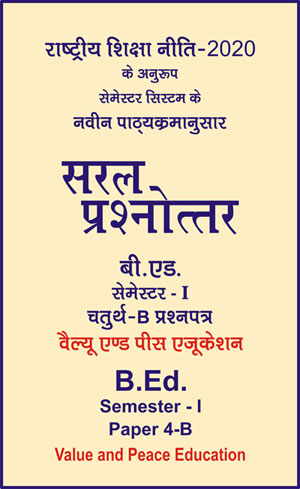|
बी एड - एम एड >> बी.एड. सेमेस्टर-1 प्रश्नपत्र-IV-B - वैल्यू एण्ड पीस एजुकेशन बी.एड. सेमेस्टर-1 प्रश्नपत्र-IV-B - वैल्यू एण्ड पीस एजुकेशनसरल प्रश्नोत्तर समूह
|
5 पाठक हैं |
||||||
बी.एड. सेमेस्टर-1 प्रश्नपत्र-IV-B - वैल्यू एण्ड पीस एजुकेशन (अंग्रेजी भाषा में)
Question- What are the Principles and Methods of World Peace?
Answer -
Sanderson (1982) suggested nineteen principles of world peace which include:
- The earth is one world and its human beings must learn to live in peace with each other or perish.
- The human race is one and inter-dependent, the good of each depends on the good of all and our love for each other.
- The way of love and peace is non-violent and does not hurt anyone.
- The uniting power of love, peace and friendship is stronger than the divisive strife of hatred, war and enmity.
- The conversion of a hostile and militaristic world into a peaceful global society is primarily an educational process of changing consciousness from fear, suspicion and mistrust to love, confidence, and trust in the human capacity to solve problems, cooperate and establish justice.
- Every human being has equal right to life, liberty, security, and justice.
- Respect for individual freedom and dignity requires the protection of all human rights by means of a universal system of justice.
- Justice in human affairs evolves through democratic means and due process of law.
- The use of force is justified only when a legal authority, designated by consent of the people, is required to restrain and bring to justice a violator of the law.
- A law enforcement official has legal authority only within the territory of the people who designate that official. No nation has the sovereign right to use any force outside its national borders.
- War, the use of force outside one’s territory, the threat to use such force, and the sale or transfer of military weapons outside one’s territory should be prohibited by international law.
- International wars and internal oppression of human rights are allowed to occur because there is no enforceable world law.
- Enforceable world law and justice may be established by instituting a democratically elected federal world government to protect human rights and solve international disputes through a compulsory system of jurisprudence.
- In a federal world government, each nation would maintain sovereignty over its own internal affairs, except that the federal world government would have legal authority to protect human rights and settle international disputes.
-
Education, communication, democratic process and non-violent protest of wrongs are the purest and most effective means of social reform, peace and justice are attained only by peaceful and just means;
-
Biological, chemical and nuclear weapons are so horrendously deadly to people and damaging to the environment for such long periods of time that only deluded minds seriously contemplate their use;
-
Belief in deterrence of war by massive armaments and nuclear weapons is based on fear, suspicion, mistrust and insecurity, this weapons policy perpetuates more fear, suspicion, mistrust, and insecurity in the world;
-
Those people who have moral courage and faith in the justice of their economic and political philosophies and in the non-violent social change of democratic process will support enforceable world law instead of massive national armaments;
-
Lastly, huge expenditures on massive armaments of destruction are a colossal waste of human and material resources, causing poverty, inflation, and a lowering of the quality of life, such resources could otherwise be used for improvement of the environment, food production and distribution, education, health and other beneficial purposes.
According to Sanderson (1982), methodological means of achieving world peace include: living peacefully and lovingly as examples to all; educate ourselves and others by every means to increase awareness of the oneness of life, the interdependence of all beings, the ecological unity of the environment, the way of love and non-violence, and the urgent need for transnational attitudes, programmes and institutions for the sake of mutual survival; communicate by every means the truth and the facts which reveal and nourish world peace; pray, mediate and expand the consciousness of peace; respect and nurture human rights with tolerance and understanding; refrain from contributing to the preparations and activities of war and from hostile and aggressive attitudes, protect non-violently against oppression, militarism, nuclear weapons, pollution and violations of human rights, work for the total elimination of biological, chemical and nuclear weapons in every country; promote and practice world citizenship, and work to organize a world constitutional convention to plan the democratic institution of a federal world government; use all human wisdom, science and technology in developing and purifying the environment, eradicating hunger and sickness in all countries and making global education available to all people; lastly, communicate closely with all peace organizations and dedicated peace workers to facilitate the forming of a united world-wide network to bring about the establishment of world peace.
United Nations (2000) stated that a culture of peace will be achieved when citizens of the world understand global problems, have the skills to resolve conflicts and struggle for justice non-violently, live by international standards of human rights and equity, appreciate cultural diversity, and respect the Earth and each other. This can only be achieved with systematic education for peace which supports the campaign of Sanderson (1982) on methodological means of achieving world peace.
|
|||||













